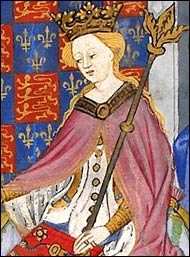
The Last Medieval Queens: English Queenship 1445-1503
J.L. Laynesmith
Oxford UP £35 312pp ISBN 0199247374
Joanna Laynesmith addresses a subject ripe for historical treatment and does it ample justice. She treats the lives of four women who lived as queens during that most turbulent of periods, what Shakespeare named the Wars of the Roses. The four queens in question – Margaret of Anjou, Elizabeth Woodville, Anne Neville and Elizabeth of York – were different in temperament, rank, education, but each was forced to make a life within the institution of queenship. This institution was already well-formed at the beginning of the period; by 1445 a clear etiquette existed around the diplomacy of marriage-making, rituals for coronation of queens were well-practised, bureaucratic underpinning for the queen’s household, as well as convention for visual representation of female majesty. Yet each one of the queens also moulded the institution, and in this manner contributed to the political culture, while also forming a legacy of expectations for the next queen.
The Last Medieval Queens is divided into five thematic chapters which treat the selection of the queen, rituals of queenship, queens as mothers, the queen’s family circle and court and household. Within each chapter all our queens are treated, yet in some a single figure may dominate, for good historical reasons. It is not surprising, therefore, to find much detailed attention, based on royal accounts, to the rituals which surrounded Margaret of Anjou’s arrival in England and the celebrations which followed; while Elizabeth Woodville and her ample circle of kin loom large in the chapter on the Queen’s Family.
The book is the fruit of a great deal of careful work on a wide range of sources – royal accounts, chronicles, visual representations, royal prayer books, treatises on conduct. It also displays sustained and sophisticated thought about the nature of politics, about the tensions between the public and the private in the lives of those who rule (then as now). She is attuned to the meaning of femininity and the many frames within which women were perceived in the later Middle Ages. These sophisticated approaches are an example of integrated medieval studies at their best, and are a tribute not only to Dr Laynesmith’s own intelligence and sensible eclecticism, but also to the training that she received at the York Centre for Medieval Studies. Only such ease in treating religious sources as well as chancery rolls, art as well as parliament, can produce a fuller understanding of late medieval political culture.
This political culture arises from The Last Medieval Queens not only as deeply dynastic in its loyalties, but also imbued with the language of religion. The degree to which politics absorbed religious imagery is becoming increasingly clear from current research. The late medieval queen, and especially the late medieval royal mother, turned to the powerful image of the Virgin Mary. Subjects sought in the Marian idiom apt modes of address, as when the burghers of Norwich chose a performance of the ‘Salutation of the Virgin and Elisabeth’ to welcome Elizabeth Woodville into their city in 1469. Henry VII and Elizabeth of York were embraced as members of the Confraternity of the Immaculate Conception in London in 1503. Fecundity and purity, majesty and wisdom in the figure of Mary offered consolation and example to women who lost sons to the bloody politics of dynastic strife.
Weaving together institutions and personality, family and realm, intimacy and ceremony,The Last Medieval Queens, is a wise book by a young and lively scholar. It is well written and beautifully produced, and is worthy of a wide readership both academic and popular.
No comments:
Post a Comment